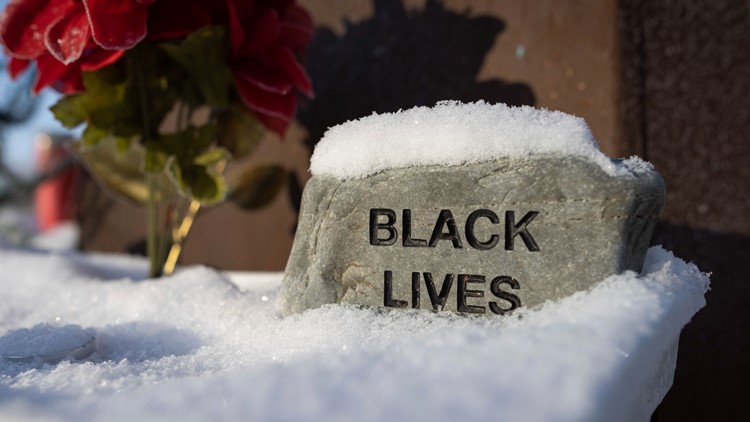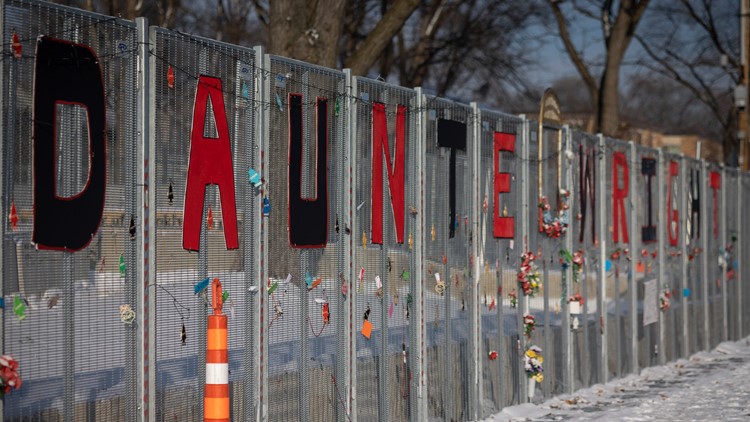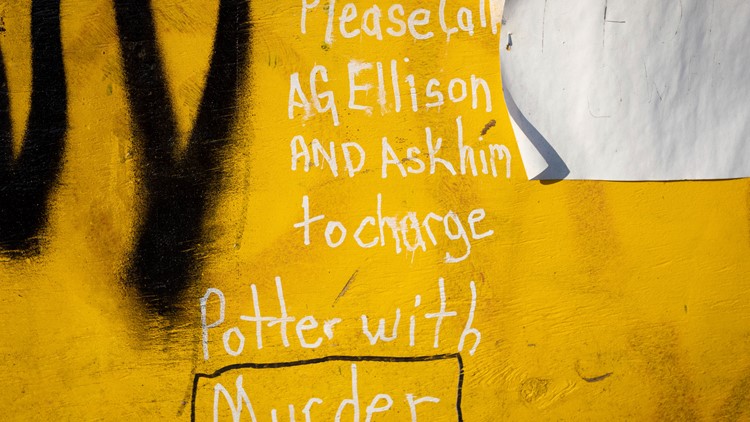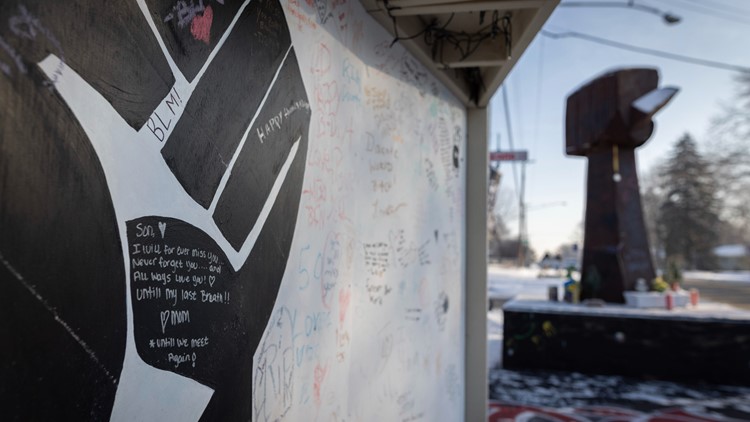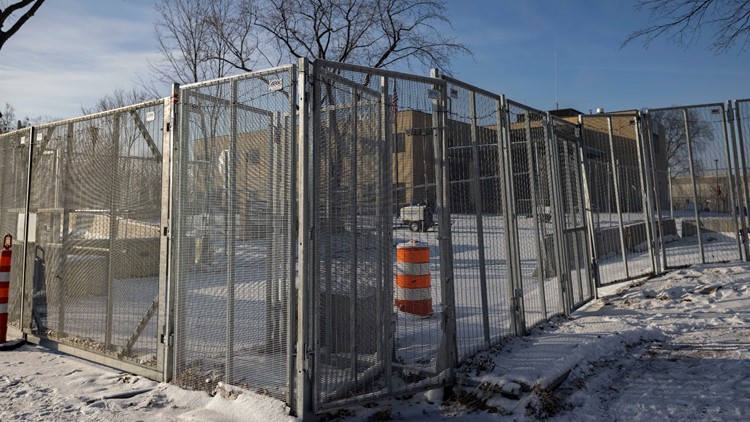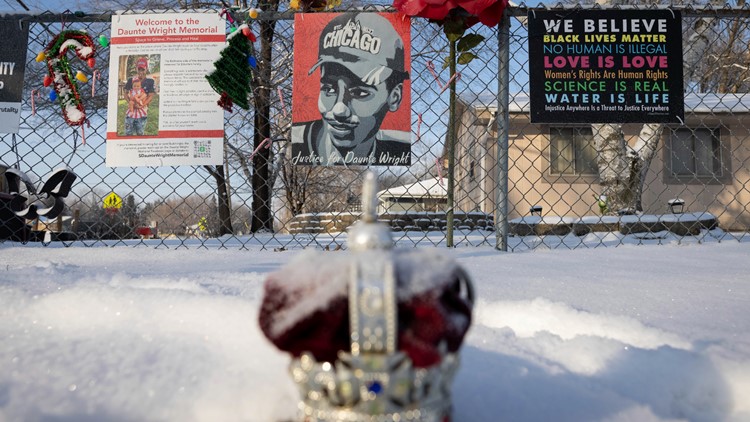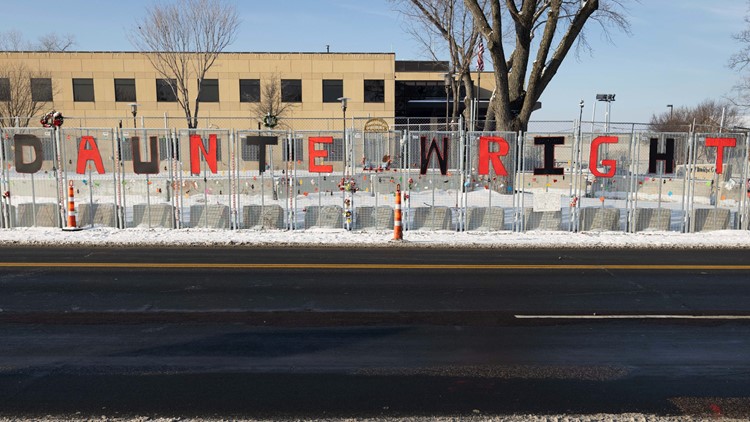MINNEAPOLIS —
- State says it will rest Thursday
- Daunte Wright's father, Arbuey Wright, gave an emotional testimony, saying he had a "close relationship" with his son
- State's expert witness testified about Kim Potter's use of force
- Brooklyn Center officers Commander Garett Flesland and Sgt. Mike Peterson testify that Potter was up to date on department policies, procedures and taser training
- Prosecution's witnesses review differences between guns and Tasers, Daunte Wright's autopsy and evidence found at the scene of the shooting
Wednesday, Dec. 15, 2021
The sixth day of the trial of Kim Potter, the former police officer charged with manslaughter in the April shooting death of Daunte Wright, began with the defense’s cross examination of Brooklyn Center Sgt. Mike Peterson.
Peterson agreed with defense attorney Paul Engh that the way officers respond to an incident depends on their training. He told Engh that it is consistent among the department for officers to warn a suspect about being Tased before discharging it. Engh then argued why a gun may be necessary in certain circumstances, asking Peterson if he agreed that officers can use deadly force if there is a threat of great bodily harm. Peterson said yes. Peterson then told the court Potter had a reputation for being peaceful and law-abiding.
As prosecutor Matthew Frank began his redirect questioning, Peterson testified that officers usually take backdrop into consideration when deciding to use a weapon, which is described as what’s happening behind the intended target. Engh followed by asking if an officer is seen in a car trying to stop a suspect from leaving, if that suspect should, indeed, be stopped. Peterson said yes.
The first new witness for the prosecution Wednesday was Seth Stoughton, an associate professor at the University of South Carolina School of Law who studies police culture, regulation, behaviors and more. Stoughton’s testimony hinged on the difference between a threat and a risk, and whether Potter’s response was reasonable under the circumstances of the case.
Stoughton told the court that both the use of deadly force with a firearm, and the use of a Taser, would not be reasonable or proportionate to the perceived threat under typical police conduct. He further told prosecutor Frank that Wright presented a threat of escaping arrest, not of imminent threat or harm to Potter or the other officers at the scene. He argued that because they were aware of several of Wright’s identifying factors, it would have been more tactically beneficial to let him go and make an arrest later. He cited the possible dangers of incapacitating a person who was in a position to operate a motor vehicle, as the evidence showed was the case for Wright at the time of his shooting death.
Defense attorney Earl Gray started Stoughton’s cross examination by asking him to clarify his statements about whether he believes the officers at the scene should have “let him go” and attempt an arrest at a different time. Stoughton echoed his earlier testimony, saying the fact that he was identified by officers would have made it a reasonable consideration. He repeated that he believed using deadly force against Wright was unjustified and inconsistent with general police policies.
Throughout his questioning, Gray repeatedly stated that it had been 15 years since Stoughton had been a patrol officer and asked about any critical incidents he may have been involved in, trying to draw parallels to Stoughton’s experience in the field to the incident in which Wright was killed.
As Gray continued, the court reporter asked Judge Chu on at least two occasions to ask both Gray and Stoughton to stop talking over each other. Chu stopped testimony to tell Gray and Stoughton to wait until the other is done talking, citing a “messy record” should they continue.
After Gray’s questioning came to a close, the state called Arbuey Wright, Daunte’s father, as its last witness. Wright gave an emotional testimony, describing his family and their relationships. He told the court that he and his son were “close” and that Daunte “loved” being a father to his son, Daunte Jr.
“He loved his son. I loved Daunte. He was loved. I miss him a lot. Every day,” Wright said.
The defense decided not to cross examine him.
Judge Chu then dismissed the jury, reminding them to stay away from any news, research or social media posts about the case. She also told them to plan ahead in the morning due to expected bad weather and poor travel conditions. She said told them she intends to start court on time.
After the jury left the courtroom, prosecutor Joshua Larson noted that the state will rest tomorrow, and motioned to prohibit “needless evidence” from a list of character witnesses presented by the defense. He said much of that testimony will be redundant. Larson then asked to limit the opinions of two particular witnesses, who said may have opinions beyond the scope of the court’s prior ruling.
Chu asked for a witness summary to be provided to her, and reminded both legal teams that specific instances of good conduct are not admissible.
Court is scheduled to resume Thursday at 9 a.m.
LIVE UPDATES:
4:31 p.m.
Judge Chu dismissed the jury, reminding them to stay away from any news, research or social media posts about the case. She also told them to plan ahead in the morning due to expected bad weather and poor travel conditions. She said she intends to start court on time, Thursday morning at 9.
After the jury left the courtroom, prosecutor Joshua Larson noted that the state will rest tomorrow, and motioned to prohibit “needless evidence” from a list of character witnesses presented by the defense. He said much of that testimony will be redundant.
Engh told Chu the defense has five witnesses scheduled for Thursday, but doesn’t yet know if the defense team will call on all of them.
Chu told Engh he could pick three of the five witnesses the defense planned to call.
Larson then asked to limit the opinions of two particular witnesses, who said may have opinions beyond the scope of the court’s prior ruling.
Chu asked for a witness summary to be provided to her, and reminded both legal teams that specific instances of good conduct are not admissible.
Engh then brought up Stoughton, and said his witnesses should be permitted to agree with his testimony. Chu told Engh she would take his request under advisement and dismissed the court.
4:20 p.m.
The last witness called by the state Wednesday afternoon was Arbuey Wright, Daunte Wright’s father. Wright went on to give an emotional testimony, describing his family and their relationships.
Wright stated that he had three children with his wife Katie, and that Daunte was their first-born.
“We did a lot of things as a family,” Wright said. “That’s all we have.”
He went on to describe their relationship as “close,” and tells a story about getting Daunte a job with him at Famous Footwear, which ended when the COVID-19 pandemic started.
Prosecutor Erin Eldridge then asked Wright to talk about his grandson – Daunte’s son – Daunte Jr. He told the court that Daunte “loved his son” and was happy to see him happy as a father.
“He loved his son. I loved Daunte. He was loved. I miss him a lot. Every day,” Wright said.
The defense did not cross examine Wright.
4:01 p.m.
Defense attorney Earl Gray continued his questioning of Stoughton after the court’s afternoon break, asking him about his previous research about police body-worn cameras. Gray cited a 2018 article that Stoughton had written, discussing the limits of video interpretation. Stoughton agreed that his article stated cameras have limitations, as well as their users, including cognitive bias, which is described in court as a “motivated reasoning to find a tendency of people to conform to some other goal than accuracy.”
During redirect questioning from prosecutor Frank, he asks Stoughton if he would agree he was “very careful to avoid cognitive bias” in this case, to which he answered, “To the maximum possible, yes.” Frank went on to show a still image from body camera footage, showing Potter’s point of view as she held her firearm up to Wright. Frank asked if based on the footage, Potter would have been able to distinguish between her Taser and firearm after she unholstered it, to which he agreed.
3:03 p.m.
Defense attorney Earl Gray led the cross examination of Stoughton, asking him to clarify his statements about whether they should have “let him go” and attempted an arrest later. Stoughton echoed his earlier testimony, saying the fact that he was identified by officers would be a reasonable thing for them to weigh against escaping. He repeated that he believes using deadly force against Wright was unjustified and inconsistent with general police policies.
Gray then asked Stoughton about his time as a police officer, repeating throughout questioning that it had been about 15 years since Stoughton had been on patrol. He asked whether Stoughton had ever been involved in a “critical incident,” to which he replied he had. Gray appeared to attempt to draw parallels to Stoughton’s experience in the field to the incident in which Wright was killed.
As Gray continued, the court reporter asked Judge Chu on at least two occasions to ask both Gray and Stoughton to stop talking over each other. Chu stopped testimony to tell Gray and Stoughton to wait until the other is done talking, citing a “messy record” should they continue.
2:46 p.m.
Judge Chu excused the jury for a 10-minute break to address attorney Engh’s question as to whether or not the state opened the door to evidence about Wright’s prior fleeing incidents.
Engh argued that the premise of Wright being able to be apprehended later is a false predicate. He told Chu the defense would ask for a mistrial if they can’t introduce evidence of Wright’s previous record of fleeing police.
Prosecutor Frank told the court that he believed there has been no false impression given to the jury because Stoughton’s testimony was about what a reasonable officer would have done, based on the information they had at the time.
Chu said she was concerned by the jury’s potential understanding that Wright could have been arrested easily because there’s evidence that he might not have been.
Chu left the courtroom briefly to review the situation, coming back to decide she would to not allow the defense's proposed evidence, saying it would only be admissible if Potter was aware of his prior attempts to flee.
2:05 p.m.
Professor Stoughton returned to the stand after a lunch break, further explaining why he believed Potter’s use of deadly force was unjustified under the circumstances of Wright’s death.
He stated that he believed Wright presented a threat of escaping arrest, not of imminent threat or harm to the officers. He said because the officers were aware of Wright’s identity and several identifying factors of his address and contact information, he was unlikely to avoid future apprehension, therefore, an officer under this circumstance would pursue an arrest later.
Stoughton also told prosecutor Frank that he believed the use of a Taser would have been inappropriate under those circumstances, as Wright was in a position to operate a vehicle. He said that by potentially incapacitating Wright while driving, it would have created an even more dangerous situation.
He then went on to describe the positioning of Wright in relation to Potter as she allegedly meant to draw her Taser and use it to incapacitate Wright. Stoughton explained how a Taser needs a specific range of spread between the Taser’s prongs on a person’s body to be effective. He said Potter and Wright would have been too close, and the discharge of a Taser from that range would have likely only resulted in pain.
12:30 p.m.
The prosecution’s second witness of the day was Seth Stoughton, an associate professor at the University of South Carolina School of Law who studies police culture, regulation, behaviors and more. Stoughton has a background in law enforcement and worked as a police officer for several years in Florida. He received a law degree from the University of Virginia and was retained by the state in this case to testify as an expert witness. One of the things prosecutor Matthew Frank asked Stoughton to explain was the difference between a threat and a risk. Stoughton defined a threat as when “a reasonable officer perceives the subject as having the ability, opportunity and intention to cause a particular type of harm.” A risk would be when an officer is missing one of the three elements listed above. Stoughton testified that officers can use a range of tools to manage risk but can use force to address risk.
He also explained that when reviewing use of force, it has to be determined if the response was proportional to the threat. Stoughton reviewed the body of evidence in the case and told the jury that in his opinion, the deadly force used by Kim Potter against Daunte Wright was excessive and not appropriate.
Frank played video from the body worn camera worn by Sgt. Johnson on the day of Wright’s death. The video shows the second that Johnson reached into Wright’s car and how he backed out of the vehicle after hearing Potter yell “Taser Taser Taser.” Stoughton testified that because at the time Johnson was preventing Wright from operating his vehicle by grabbing the gear shifter, there was no threat once Johnson backed out of the car. Therefore the use of deadly force wouldn’t have been reasonable or proportionate.
10:30 a.m.
Court resumed Wednesday morning with cross-examination of Brooklyn Center Sgt. Mike Peterson by defense attorney Paul Engh. Peterson agreed that officers respond differently to their training but said it’s consistent among the department for officers to shout “I’ll Tase you” before deploying a Taser. He testified that mistakes can happen when someone uses a Taser, and mistakes can happen when someone uses a Taser instead of a gun. Engh asked if when there’s an apparent risk of great bodily harm, can officers use deadly force to prevent escape or make an arrest? Peterson said yes. The defense concluded its cross-examination by asking Peterson if Potter has a reputation for being peaceful. The state objected to the question, which was overruled by Judge Regina Chu. Peterson testified that she has a reputation for being peaceful and law abiding.
During redirect questioning by the state, Sgt. Peterson testified that generally people who don’t have a license or insurance fail to follow the rules of the road as well as people who do have those documents. Peterson agreed with prosecutor Matthew Frank that not having insurance alone doesn’t make a person unsafe, but said that’s not something officers know before making a stop. When asked about the department’s Taser 7 model, Peterson testified that the basic functions of that weapon aren’t much different from the BCPD’s previous Taser model. He also agreed that officers have to take backdrop into consideration when using a firearm or Taser - which is what’s happening beyond your target.
Peterson was questioned again by Engh, who asked in a hypothetical situation, if an officer is seen inside a car trying to stop an individual from leaving, should that person be stopped? Peterson said yes.
Judge Regina Chu addressed two motions in the trial of Kim Potter, a former Brooklyn Center police officer charged in the April 2021 death of Daunte Wright.
Potter is charged with one count of first-degree manslaughter and one count of second-degree manslaughter.
The first motion from the prosecution asked that evidence of bias by union members be allowed, as Potter was a police union president as recently as 2019. Judge Chu rejected the motion.
In the second motion, prosecutors said the defense tried to turn officer Sgt. Johnson into an expert witness and wanted the jury to disregard those opinions. The defense said the state didn’t object at the time of Johnson’s testimony and noted that he was the prosecution’s own witness. Judge Chu said she won't order the jury to disregard Johnson’s opinion.
Commander Garett Flesland: The Brooklyn Center Police Department (BCPD) commander testified that he oversees trainers for the BCPD and reviews training programs. He said Potter was up-to-date on certain policies and procedures within the department, including a certification to use a Taser since 2002.
Sgt. Mike Peterson: Also with the BCPD, Peterson explained Taser training and use as it aligns with BCPD policy. He said his goal is to cross-train officers on how to use as many platforms as they can to retain a commonality of techniques and a vast array of responses. Documents presented in court showed Potter's most recent training was completed on March 2, 2021.
Watch more on the death of Daunte Wright:
Watch the latest coverage on the death of Daunte Wright and the trial of Kim Potter in our YouTube playlist:
Scenes from Brooklyn Center as opening statements begin in Kim Potter trial



